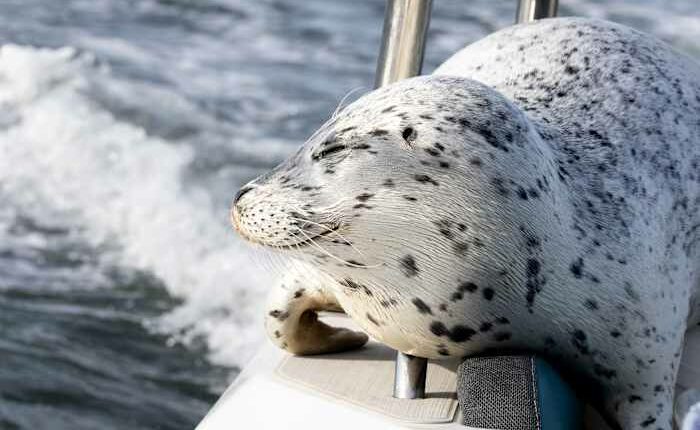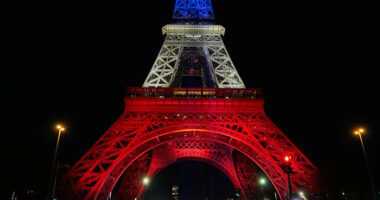Share this @internewscast.com

SEATTLE – An exhilarating encounter unfolded as a wildlife photographer, while on a whale watching excursion off Seattle’s coast, filmed a gripping scene of a pod of killer whales in pursuit of a seal. The seal’s escape was nothing short of miraculous as it managed to hop onto her boat’s stern for safety.
Charvet Drucker had set out in a 20-foot (6-meter) rental vessel from her island residence in the Salish Sea, about 40 miles northwest of Seattle, when she observed a group of at least eight orcas. Known for their strategic hunting techniques, these killer whales were executing coordinated maneuvers and tail slaps, indicative of their hunt. Through her camera’s zoom lens, Drucker caught sight of a harbor seal desperately attempting to evade the pod. One dramatic image captured the seal airborne amidst the swirling orcas, leading her to believe she was witnessing the seal’s final moments.
As the orcas drew nearer to the boat, it became clear that the chase was still on. Abiding by wildlife boating guidelines, Drucker and her companions turned off the engine to avoid causing harm to the whales. In a desperate bid for survival, the seal hoisted itself onto the boat’s swim platform near the motor, effectively transforming it into a temporary refuge.
While wildlife protection laws prohibited any direct contact or assistance to the seal, Drucker took out her camera to document the dramatic scenario.
In the footage, Drucker can be heard expressing sympathy as she reassures the seal, “You poor thing,” she says, “You’re good, just stay, buddy.”
“You poor thing,” Drucker can be heard saying, as the seal looks up at her. “You’re good, just stay, buddy.”
The orcas did not give up immediately, but instead appeared to team up to rock the boat and make the seal fall off. Drucker’s cellphone video shows the orcas lining up and moving in on the boat with staggered dives to create waves. The “wave-washing” technique has been documented since by scientists since at least the 1980s, according to the National Oceanic and Atmospheric Administration.
The seal on Drucker’s boat slid off at least once, but managed to climb back on, and the orcas swam away after about 15 minutes.
Drucker has photographed dead seals in the mouths of orcas before, and she says she’s generally happy when the whales get to eat.
“I’m definitely Team Orca, all day, every day. But once that seal was on the boat, I kind of turned (into) Team Seal,” she said in an interview with The Associated Press on Thursday.
The killer whales that hunt seals and a diverse set of marine animals in the area are known as Bigg’s or “transient” orcas. They are better fed then other more specialized species like the salmon-focused “resident” orcas who are on the endangered species list, according to NOAA.
Copyright 2025 The Associated Press. All rights reserved. This material may not be published, broadcast, rewritten or redistributed without permission.










